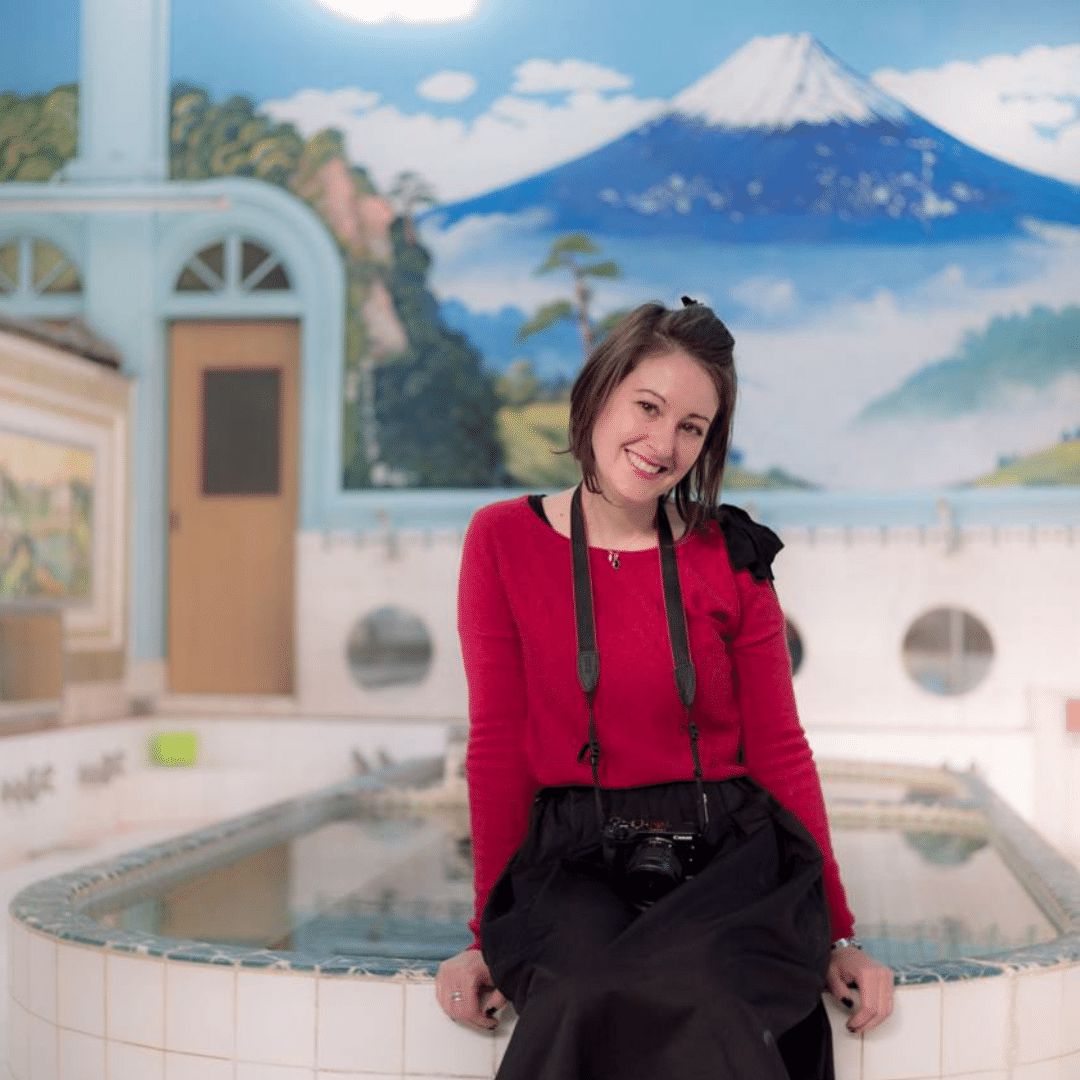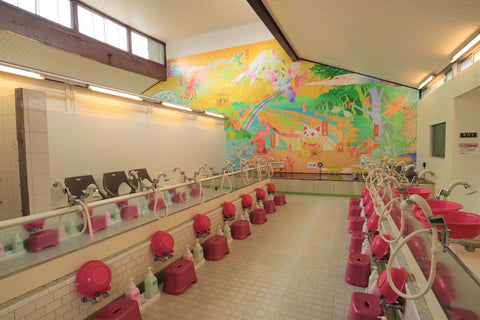
Let's Meet Japanese Bathhouse Ambassador Stephanie Crohin
We were delighted to recently have a chat to Stephanie Crohin, a French ex-pat living in Tokyo, Japan. She has lived in Japan for over 10 years now and during that time has fallen in love with the long standing tradition of attending Japanese bathhouses (know as Sento in Japanese). I felt we shared a common affinity with our love of Japanese culture and having the opportunity to share the joy we feel for Japanese culture and uniqueness with the rest of the world.
Without further ado, let's dive into the Q & A with Stephanie.

- Where did your story with Japan begin?
My Japan journey started when I was in high school, I discovered Japanese literature. I always loved books. I loved the sensibility in Japanese literature, I fell in love with it. For me it was a bit similar to the French literature.
I had a big car accident when I was 18 and the insurance gave me some money to help me with my study. The insurance gave me 3500 Euro because I sustained damage to my body. I was working hard to pay my University studies and I should have used this money for it but I really wanted to change this trauma into a positive experience, so I used the money to travel in Japan.
I bought a Japan rail pass and travelled for 3 weeks. I loved Japan but was frustrated because it was hard to communicate with people. I decided to study Japanese when I went back in France. I wanted to study interior design but study was very expensive in France. I entered university and studied Japanese. So it was my first experience with Japan. I studied hard and was also working at the time but I really wanted to succeed and go back to Japan. In 2008 I moved to Tokyo as an exchange student.
- What were your first impressions about sento when you visited back in 2008?
At the time I didn't know about Sento because we didn't have information available in foreign languages. Even though Japanese people don't talk a lot about Sento at that time. My French friend discovered a Sento near the University. We had to do some homework about Japanese culture so she decided to do it on the Sento she visited. She asked if I wanted to come and visit. I went to an Onsen once in Hakone because I like to new experience things I've never done before.
The first impression was feeling shy as you have to become naked to bathe. Naked in front of your friends could also be a bit uncomfortable, especially not being children but 23. I realised that people around us weren't paying attention, it was just natural and common to be naked. In about 5 minutes I no longer felt comfortable. I got used to it and I realised Sento was a real community and I really loved it. I always loved bathing and the kindness of the people . I wasn't feeling like a foreigner, just one of the people. I was also practising my Japanese there and the architecture of the Sento was amazing. I paid attention to many details such the tiles and interior. After that I visited many sento and discover that each sento has a different architecture and interior with true character.

(Daikokuyu Sento, Fukuoka)
- Is there a Sento on your bucket list that you are still yet to visit?
I have so many left that I would like to go. I stopped my work in a Japanese company in 2016 and now I'm a freelancer. Even though I have free time, it's not enough money to pay the rent. I'm trying to visit many sento and introduce them to others but it takes money to travel. If I have work in a certain area I try to visit as many as I can while I'm there..
I have visited over 1000 Sento , but I still haven't been to Shikoku and Hokkaido sento. There is one Sento I still want to visit in Okinawa too. So there are many on my bucket list yet to visit.
When I am visiting a city, there is maybe one or two I never went to before but I also want to visit the ones I have already been too, to visit the people I know there.
I really have strong connections with many Sento across Japan. They are like a second family. Even if I don't seem them for three or four years, when I go back, they're always welcome me very warmly. I feel very connected to these people and I really love them.

(Ebisu-yu, Tokyo)
- If you had visitors to Japan, which sento would you take them to first?
When I guide people to Sento, or when people ask me for Sento recommendation, I try to find out about the person.
What do they want to visit in Japan? What do they like? Do they prefer luxury or retro style? I try to have many criteria and also think if the Sento is a good match for the person.
I also try to find a location that not so far from the place they're staying. I'm like a a guide in getting people to a place, to Sento not found in the guidebook.
Sometimes, for a day I like to take a couple or one people or a family and guide them around Tokyo and to a Sento.

(Akishima-shi Fujimi-yu, Tokyo)
- Do you think that Sento will stand the test of time, particularly with the youth of Japan? Is it trendy to visit Sento as a young Japanese person or is the ritual more for the older generation?
Yes I think that Sento will stay because when I started to do the promotion of Sento, I didn't see so many young people coming. But now I am seeing more and I hope that my promotion of them helps. Most people who visit Sento will go again as they realise it's so good fo the body and for mental health.
It's just nice. It's cheap to attend too (less than $5 AUD) . Now in most Sento, you can find people ranging from young to old. I don't think the sense of Sento culture will disappear and many are being renovated and improved to make more attractive to visit too.
- Do most Sento have artwork on their walls?
Yes it's an often under-discussed charm of the Sento. From the architecture of the building, to the garden (if it has one), to the tiny tiles leading into the bath, Sento usually has a multitude of art and design aspects.
I think more than half of Sento I have visited have had artwork whether they are on the wall or the amazing floor tiles or carved traditional details in the building roof!

(Akebono Yu, Tokyo)
- Is the artwork usually related to the area that the Sento is located?
As you might expect, representations of iconic Mount Fuji are very popular among the traditional Sento. Others have painted landscapes showing the local area. For instance, inside a Kagoshima Sento (at the extreme south of Kyushu) you won’t find Mount Fuji but Sakurajima, the region’s notorious volcano. In Niigata, I have seen beautiful mosaics inspired by the traditional dance of Sado Island, which is located in the same prefecture.
In other Sento you may find replicas of famous paintings by Western artists such as René Magritte or Pierre-Auguste Renoir, typically executed as tile mosaics, or scenes of dreamy castles in Switzerland or even Hawaiian resorts. In more ways than one, exploring sento across Japan is a way to spice up your trip and discover new places—whether through local recommendations or through depicted scenes from far away.
- Part of why I enjoy drinking Matcha is the chance to take a moment to focus on the task at hand, relax and enjoy the moment and block out any other distractions. Do you feel something similar to this sensation when visiting Sento?
Yes I think I feel the same than you. I took some classes so I know about the focus you can have when drinking Matcha. When you go to Sento, just like when you shower, you can let your feelings be released with the water, all the trouble you have in the day, all those negative feelings. So it's again, it's mediative like drinking Matcha and concentrating on the moment to relax and de-stress.
The ritual of washing your body and listening to the sound of running water just makes you feel relaxed. It's a detox and a moment with yourself and also a moment to share with friends and family, as you can when drinking Matcha.
You share the Sento space with other users, you can make conversation but you don't have to. You have to respect the people around you.
I also think it's so important for young people presently, as we are always in front of our screens and Sento provide a welome detox. We can't look at our phones, we just detox with the water being relaxing and like meditation.
It's just super nice to forget about your worries. And there are studies to prove that people going to a Sento helps with mental health and fostering positive body image as you see bodies of all shapes and sizes at Sento.

(Hakusan-yu Toyosu Otokoyu, Tokyo)
- We both have strong connection to Japanese culture, how do you feel when promoting this aspect of the culture to people both in Japan and abroad?
I thought promoting Sento will be just a small occupation, but I want to do something even small to help those Sento facing potential closure. So I started to share on Instagram and little by little, the media has paid attention. I am being interviewed regularly for TV, radio and magazines . I think it's a good way to promote.
I really hope people will continue to know about the cultural importance of Sento. I have published a book in French but would like to publish a book in English because it will allow many people to be aware about the culture.
To learn more about the wonderful world of Japanese sento brought to you by Stephanie you can:
Visit https://dokodemosento.com/
Follow her @_stephaniemelanie_
